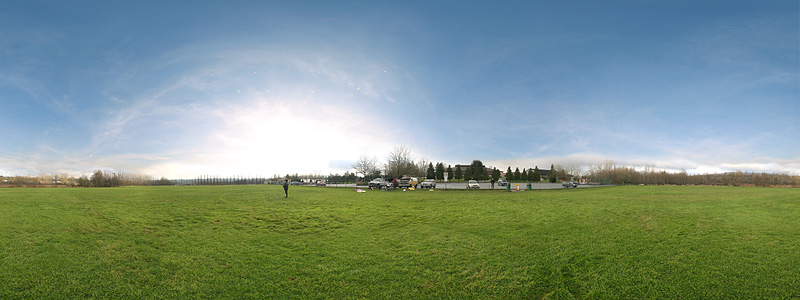Reflex XTR panorama - Burnaby Lake
Click on the thumbnail to download the larger version. If you have trouble unzipping the file click here to download jpg file directly.Please consider a small donation to keep this download available.

8160 x 3060 pixels
Copyright © 2006, AerialPhotoImage.com
Creating 360į degrees panoramas - technical notes.
|
Iíve created this panorama to be used with Reflex XTR, but in fact the same image can be imported in any other flight simulator that supports custom panos. For stitching the images Iíve tested several software products, including Panorama Tools, and finally choose PTGui as best. All products had problems finding control points and rendering the sky. The grass area was also problematic. Initially I was using the full resolution 6 mega pixels frames, but this turned to be too heavy for my machine. And I have fairly decent system by todayís standards: AMD 64 3000+ on Asus A8N SLI Premium, 6600GT, 2GB RAM and 250GB HDD, running XP Pro SP1. Using batch automation I resized the original images to 1200x1800 pixels. Despite that, working with all of them (176 images total) in a single project was still very slow. I found it is almost impossible to build a panorama if I load all information in a single project. The tool would correctly identify many control points around the horizon line (plus, minus 15 degrees) but the clouds and the grass where all over the place.
So I decided to split the panorama in 3 separate projects and blend the results manually in Photoshop. My first project was to stitch the horizon area between -15 degrees and +30 degrees, 4 rows x 36 = 144 images total. PTGui did outstanding job finding the control points, yet I still had to add manually about 50 or 60 points myself for better accuracy, mainly in the sky area. Then I did the bottom grass area in a single row (17 images), followed by the remaining part of the sky also in a single row (15 images). These two where originally shot with my Sigma 15-30mm @ 20mm as distinct from previous batch for which I used 50mm prime lens. All shots are in portrait mode. I optimized and saved panoramas as TIFF files at 25,000 pixels horizontal resolution, each file approximately 570 MB in size. Now I had to merge the 3 pieces together. Working with such gigantic images in Photoshop is a real pain. A simple operation like cropping takes up to 3 minutes to complete on my workstation. I did not want to downgrade the resolution at this point so I can obtain the highest possible quality. I did some adjustments, so the images will have the same visual appearance and carefully blended the layers. The sky was really problematic, as in my second session there where fewer clouds and a bit different color temperature. Once done I saved the PSD file which turned to be a whopping 1.5 GB in size. I than flattened and resized the image to 8160 x 3060 pixels and carefully did some sharpening using Ultrasharpen Pro 5.0 plug-in. Saved it as JPEG image at 80 quality and that was it. Now, the only thing is to figure out how to build the collision map, but for this we will need the help from the creators of Reflex. I have to say that working on this project was fun. Now that I have my personal experience in building 360 degrees panoramas, I know what I could have done differently (better). Most importantly, the initial set of images must be created in a single session. An overcast sky moves rapidly and has to be covered in shortest possible time in order to avoid issues with moving clouds. Because the sky is more forgiving to distortion errors it can be covered using wide angle lens and fewer shots done by hand. The grass area can also be covered using hand held camera and wide angle, but it is a bit more demanding. All camera settings, including the focus, have to be set to manual and be consistent for all images. For the lowest row, that only contains grass I adjusted the focus, so I get a sharper version. I found that underexposing my RAW pictures by half a stop gives me better dynamic range to work with, especially the bright parts of the sky, where digital cameras tend to burn out details. I can Ďliftí the darker areas later during the RAW conversion and have the final touch in Photoshop. Ultimately I would like to repeat the session with another set of images taken in better weather conditions and consistent in time. I would probably borrow my friendís Canon 10D, as my Digital Rebel is rather slow saving RAW images after the initial 5-6 shots (even when using SanDisk Ultra II flashcard). This is a real drawback when capturing the sky part. As compromise, I might capture the sky in JPEG format with lower resolution. I think using camera with bigger sensor (more than 6 mega pixels) will not give you any real advantage for this task. Lens quality is much more important. For the areas with great number of details (horizon) I would recommend using 50mm prime lens, but most of todayís zoom lens will be good enough. PTGui knows how to read the EXIF information out f your images, and will correct for most of your lens errors. I canít stress enough how much I recommend this tool (please note, I have no connections with them). For a feedback, please write to .
|